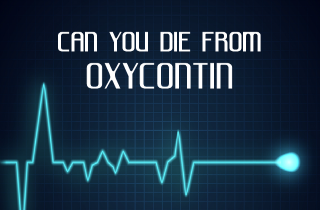Yes, there have been a number of deaths attributed to OxyContin narcotic use.
This powerful analgesic may be more lethal than any other opiate compound. The most common cause of death while taking OxyContin is drug overdose (often unintended, when people get high on oxycodone). Here, we review symptoms of OxyContin overdose and let you know what to do in the case of taking too much OxyContin. We welcome your questions about OxyContin use or its dangers at the end.
Medical uses for OxyContin
OxyContin, introduced in 1995 by Purdue Pharma, was designed to manage pain with a time release formula that dribbled one dose of oxycodone over many hours. Physicians prescribe OxyContin for moderate to severe pain caused by arthritis, bursitis, dislocations, fractures, chronic back problems, carpal tunnel syndrome, nerve damage, sickle cell disease, cancer, or injuries. OxyContin is also used to relieve coughs, diarrhea, and postoperative and post labor pain.
What’s in OxyContin? What are the dangers of OxyContin ingredients?
OxyContin is a pure form of oxycodone. Oxycodone is the only active ingredient found in OxyContin and is an opioid or synthetic opiate agonist. Oxycodone is available as prescription pain reliever that is often combined with ibuprofen or acetaminophen. All other brand forms of oxyocodone are mixed with additives, or other medications such as acetaminophen or aspirin, or they are available in lower dosages of oxycodone. Only OxyContin offers straight oxycodone.
Opiates block pain but also triggers intense feelings of well-being (the feeling of getting high on OxyContin) and can create physical dependence. The withdrawal symptoms from OxyContin are also intense when you stop taking the pain medication, with users complaining of cramps, diarrhea, muddled thinking, and nausea and vomiting.
Risks of Oxycontin abuse
Several deaths have resulted specifically from the abuse of OxyContin. Abuse of OxyContin is defined as taking OxyContin other than prescribed. In other words, you are abusing OxyContin if you are:
- injecting OxyContin
- smoking OxyContin
- snorting OxyContin
- taking OxyContin in higher doses than prescribed
- taking OxyContin more frequently than prescribed
As you develop tolerance for OxyContin, you need more and more of the drug simply to stave off withdrawal. But high doses of OxyContin and too much oxycodone increase likelihood of overdose. In addition to possible overdose, you can also develop physical dependence on OxyContin, addiction to OxyContin or you can contract hepatitis B, hepatitis C and/or HIV/AIDS if contaminated needles or equipment like snorting straws are shared.
What are the signs of OxyContin overdose?
When you take the correct or prescribed dose of OxyContin, side effects are normal. When you take too much of OxyContin, symptoms become much more serious.
The first thing most likely to occur during OxyContin overdose is extreme sleepiness. But the most dangerous complication of this type of overdose is the effect on your breathing. An oxycodone overdose can cause your breathing to slow down, become shallower, and possibly stop, depending on how much medication you have taken. This can be deadly or can result in permanent brain damage if treatment is delayed and a large amount of OxyContin has been taken.
Treatment for overdose of Oxycontin
If you suspect an OxyContin overdose immediately take the user to the nearest emergency room. Primary treatment for taking too much OxyContin includes administration of an antidote (naloxone) and charcoal with a laxative may be given to try and soak up the drug that is still left in the stomach. If needed you can also call The National Poison Control Center at 1-800-222-1222 and they will give you further instructions.
Taking OxyContin dangers questions
Oxycodone is now the most abused medicine in the United States, according to the DEA annual count of drug seizures. And prescription painkillers lead to the deaths of thousands of people each year. These numbers are rising every year. Abuse of OxyContin is deadly. We are here to help.
If you still have questions about using OxyContin or its dangers, please leave them here. We will be happy to answer your questions with a personal and prompt response.









Related Posts